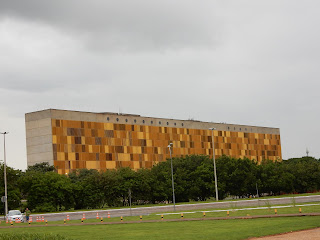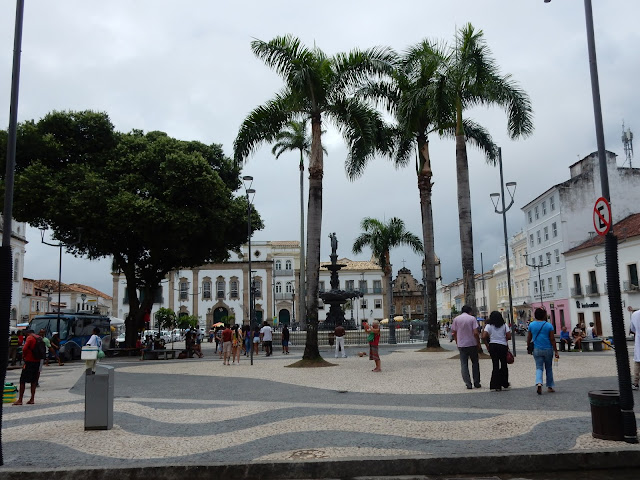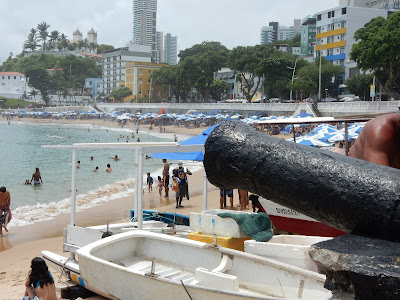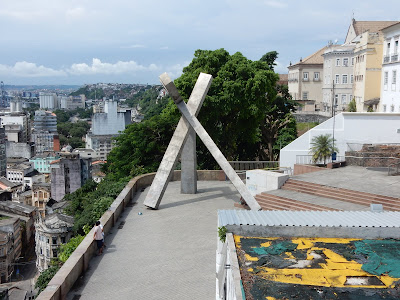BRASILIA
The New Capital
Brasilia is the embodiment in concrete of President Juscelino Kubitschek’s (JK) promise of “fifty years of economic and social development in five”, and of the national motto - Order and Progress. The city was built by vast teams of candangos , workers from the Northeast, who carved it from the cerrado at breakneck speed.
They were led by urban planner Lucio Costa, architect Oscar Niemeyer, and landscape engineer Roberto Burle Marx. The capital of Brazil shifted from Rio de Janeiro to Brasilia on April 21,1960. Brasilia was added to UNESCO’s list of World Heritage Sites in 1987 as an example of daring urban planning and modern architecture. Today Brasilia is a stately organized city.
Memorial Juscelino Kubitschek

Built in honor of the president responsible for the construction of Brasilia, the monument contains his mausoleum, with photographs of, and documents about the construction of the city.
Quarter General Do Exercito
The fusion of curves, straight lines, and jagged waves echoes the Congress complex and is the headquarters of the Brazilian army - at times the key player in affairs of state.
Museu National Honestino Guimares
The capital of Brazil, Brasilia, is shaped like an airplane
in homage to what was then the “jet age”. While to its north and south lie the residential wings, the Eixo Monumental forms the body of the jet, with the city’s major attractions.
The Suprema Tribunal Federal, the Supreme Court headquarters.
Palacio Itamarety and Palacio da Justica, two of Brisilia’s few building that are more aesthetic than monumental.
The Modernist columns seem to rise gently from the lily pond lying at its feet to form smooth arches.
Catedral Militar de Nossa Sephora de Paz
This brilliant white triangular church, with its jagged windows and vast gable, echoes the French Notre Dame du Haut, designed by Niemeyer’s mentor, Le Corbusier.
It was completed in 1991, and was built to house the papal altar used by John Paul II on his visit to Brasilia in 1980.
Quarter General do Exercito
This vast complex of imposing buildings is set in a sea of lawns and watched over by a towering obelisk. It was built during the military dictatorship and was intended to show the presence of military power in the government, which was notably absent from the Prada dos Tres Poderes.
It was the intention that the monumentalism of these generals should not be eclipsed by that of President JK.
Sanctuary of St. John de Bosco

The city’s finest church honors th 19th century Italian saint and founder of the Salesian order. It was his example that inspired Kubitschek to build Brasilia on the edge of an artificial lake. The stunning interior features an almost see less panoply of glass, which ranges from light to dark blue and indigo.
The marble statue of the virgin and the vast cross whose vertical was carved from a single piece of tropical cedar. Pope John Paul II blessed it in 1980.
Catedral metropolitans Nossa Sephora Aparecida
Designed by Oscar Niemeyer to resemble a crown of thorns, this cathedral features 16 soaring curved pillars spread like an open hand. Between them, a filigree of glass windows is united by a fluid series of colors. The main altar and the altarpiece was given by Pope Paul VI in 1967, who also blessed the metal cross on top of the building.
The statures of the evangelists outside the cathedral are by the Mineiro sculptor Alfredo Ceschiatti, who also sculpted the archangels suspended from the ceiling.
Archangels hover over the central altar, while the light marble and ample daylight infuse the entire building with a transcendent glow.
St. Mateus - Designed by Alfredo Ceschiatti (1918-1989) 10 Feet high in bronze.

This is the “PIETA” that was given to the cathedral by Rome to honor their new church.

St Luke
 |
St. Mark
|

St Matthew
 The World Cup and Soccer Stadiums
The World Cup and Soccer Stadiums
This is the apartment building that most of the people in Brasilia live in....looks a bit sterile to me...
 DAWN PALACE....
DAWN PALACE....
The official residence of the President of Brazil, located on a peninsula at the margins of Paranoa Lake. It was also designed by Oscar Niemeyer.
Watching the folding the flag in front of Dawn Palace.
This was considered a Memorial to Women.................A CLOTHSPIN!!!

SALVADOR , BAHIA. The First Capital of Brazil
The largest state in the Northeast, Bahia is known for its endless stretches of stunning beach along the Atlantic Coast.
When the Portuguese first arrived in Bahia in 1500, the entire 621 mile coastline was covered in a rainforest.
Now only a few pockets of the rainforest remain along the coast in isolated patches. Inland from the coast, the Portuguese successfully established the cultivation of sugar cane, and later cotton and cocoa in the Reconcavo, a narrow ,flat , well-watered plain, which they called the arresto.
Bahia played a key role in the history of BrazilSalvador, its capital, was founded in 1549, and served for over two centuries as the administrative and political center of colonial Brazil. The legacy of that period is on display in Salvador’s colonial core, Pelourinho, a jewel of colonial Baroque churches, cathedrals, and palaces.
It was also the key point of entry for thousands of slaves brought to Brazil from ports in Africa. The state has Brazil’s highest percentage of Afro-Brazilian residents. The percussion-driven music, the fast fight - dance known as capoeira, and the spiritualist Yoruba Candomble religion all have their roots in Africa.
 |
Michael Jackson filmed in this area for one of his videos. He used some of the Capoeira dancers in his video
|
Salvador is Brazil’s fourth largest city after SAO Paulo,Rio de Janeiro, and Belo Horizonte. Salvador offers a fascinating blend of old and new. In the colonial heart, Pelourinho, the cobblestones streets are lined with the restored 17th-and 18th-century palaces and Baroque churches. The city’s vibrant community of musicians draws from the region’s African and Portuguese heritage, blending these into a unique Bahian sound.
Pelourinho
The crown jewel of Salvador is the restored historic center, Pelourinho, which means whipping post. This originally described only the small triangular plaza in the heart of the city where slaves were public all flogged. Located on a high bluff overlooking the commercial city below, Pelourinho was built by the Portuguese in the boom years of the 18th-19th century. This area was designated a UNESCO World Heritage Site in 1985.
 |
Graffiti artists
|
Catedral Basilica. Built in 1657 , the renovated cathedral has a cedar-wood altar, and two smaller side altars, both covered in thin layers of gold. It is considered to be one of the richest examples of Portuguese Baroque architecture.
The facade is made of Portuguese lioz, a limestone. The altar contains a silver plated statue dedicated to St. Francis. It inspired a Jesuit Priest who fought against the enslavement of indigenous people. He was arrested.
Terreiro de Jesus...one of the most beautiful squares in the Pelourinho , was laid out in 1549 by governor Tome de Souza.
 This local Bahian was recently deemed to be canonized for her good works among the poor and sick.
This local Bahian was recently deemed to be canonized for her good works among the poor and sick.
Convent of San Francisco - A silver chandelier weighing 176 pounds hangs over the ornate carvings . The complex of the Church and Convent of St. Francis which was constructed between 1708-1750.
 |
Beautiful example of the Portuguese tilework.
|
Hand painted blue and white tiles decorate the walls. Azulejo - brought from Portugal in 1743. Based on etchings by Flemish painter Otto van Veen.
Igreja da Ordem Terceira de SAO Francisco - The fine 18th century sandstone facade of this church was rediscovered in the 1930’s.
Casa de Jorge Amado
Brazilian Author Jorge Amado 1912-2001 never lived here but many of his beloved novels were set in the neighborhood. He is considered Bahia’s most famous author.
Nossa Senior do Bonfim (Our Lord of Good Success)
This Church stands atop a small hill on the Bonfim Peninsula. The church was built between 1746-1754 by Captain Rodrigues de Faria in fulfillment of a pledge he made in the midst of a fierce Atlantic storm. It is important in Bahia’s Afro-Brazilian religion. The Church is dedicated to God the Father, but it also honors Oxala, the supreme deity in the Candomble . On Friday’s worshippers dress in white and dedicate their prayers to Oxala. On the right of the church in a small chapel, Chamber of Miracles.
 |
These are the wax prosthetic that represents the healing and miracles of this church.
|
 |
These people have sent pictures of the miracles they received by praying for them in this church...graduation,Dr’s , nurses....
|
 |
This man is the priest who blesses the people who come to the church.
|
Believers come here to offer items made of wax,wood, or even gold. The item represents a miracle that has been bestowed upon them. The room is packed with miracle tokens. Outside there are many colored ribbons, meant to be tied on your wrist. With 3 knots, a wish is made for each knot. The ribbon is worn until it falls off in order for the wish to be granted.
Candomble
A direct legacy of three centuries of slavery, there is a particularly strong presence of African culture in the Bahia area. Thought the slavery period in colonial Brazil, there was little or no sanction on miscegenation. Over the years, masters, slaves, former slaves, and their descendants integrated into the new society of Brazil, creating an interesting blend of cultures and bloodlines with Portuguese,Dutch,West African and Indian elements.
 |
This is the typical dress during ceremonies.
|
 |
These are religious articles that are for sale in the market for the Candomble ceremonies.
|
 This lady works in the market that sells the symbols of the Candomble.
This lady works in the market that sells the symbols of the Candomble.
This has resulted in what is called the Afro-Brazilian culture, visible in the people,clothing, religion, and music.
Of West African orgins, most of Brazil’s original slave population believed in a pantheon of deities, or Orixas. Each orixa was endowed with its own personality and unique powers, and was associated with a particular set of natural elements.
 |
These Candomble worshipers are in the square selling articles for the ceremony.
|
Worship involves the invocation of Orixas- Spirits that intervene between humans and Olorun, the Supreme Creator. The Portuguese insisted that all new arrivals be forcible converted to Catholicism. The struggle gave rise to the Candomble, a blending of Catholicism and African beliefs.
Salvador’s Atlantic Coast
The tip of Porto da Barra is the beginning of a string of ocean beaches. The best beaches for swimming are close to the southern edge of the city. Kiosks are popular on weekends.

Fun day on the beach!
 |
Part of the city’s sprawl....
|
 |
Part of a high rise complex on the hill....condos start at $3.0 million....
|
 |
The Government could have sold some of these torn buildings to Hilton...but they refused.
|

This is a community of favellas - poverty area, where the poor and homeless take over the land and build communities.
Sisters of Mercy who ran a hospital for the poor and elderly....
 The chapel in the hospital...
The chapel in the hospital...
This was the interior of the hospital. The beautiful Portuguese tile, and the hand carved altar.
 |
A View from the window...
|
TWO RESPECTED ARTISTS......CARYBE & VERGER......
Painter....and........
Photogropher..............
Market Delights......

Blue Crabs.....

Fresh lemons,limes mellons

Anchovies

Many types of peppers...most of them Hot!

What would we do without Uber Eats....
 |
My sweet tour guide Gabriella eating a coconut in the square.
|
 Beautiful memory.......
Beautiful memory.......
Goodbye to this beautiful city!!!!



 The World Cup and Soccer Stadiums
The World Cup and Soccer Stadiums DAWN PALACE....
DAWN PALACE....

 This local Bahian was recently deemed to be canonized for her good works among the poor and sick.
This local Bahian was recently deemed to be canonized for her good works among the poor and sick. 





 This lady works in the market that sells the symbols of the Candomble.
This lady works in the market that sells the symbols of the Candomble.




 This is a community of favellas - poverty area, where the poor and homeless take over the land and build communities.
This is a community of favellas - poverty area, where the poor and homeless take over the land and build communities.  The chapel in the hospital...
The chapel in the hospital...











































































































No comments:
Post a Comment